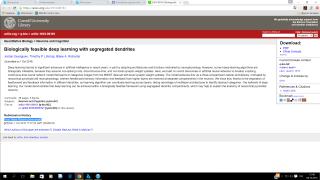
Deep learning has led to significant advances in artificial intelligence in recent years, in part by adopting architectures and functions motivated by neurophysiology. However, current deep learning algorithms are biologically infeasible, because they assume non-spiking units, discontinuous-time, and non-local synaptic weight updates. Here, we build on recent discoveries in artificial neural networks to develop a spiking, continuous-time neural network model that learns to categorize images from the MNIST data-set with local synaptic weight updates. The model achieves this via a three-compartment cellular architecture, motivated by neocortical pyramidal cell neurophysiology, wherein feedforward sensory information and feedback from higher layers are received at separate compartments in the neurons. We show that, thanks to the separation of feedforward and feedback information in different dendrites, our learning algorithm can coordinate learning across layers, taking advantage of multilayer architectures to identify abstract categories - the hallmark of deep learning. Our model demonstrates that deep learning can be achieved within a biologically feasible framework using segregated dendritic compartments, which may help to explain the anatomy of neocortical pyramidal neurons.